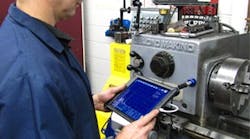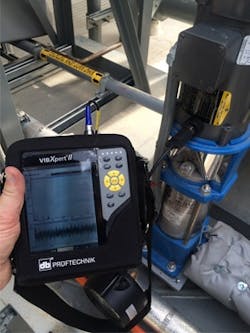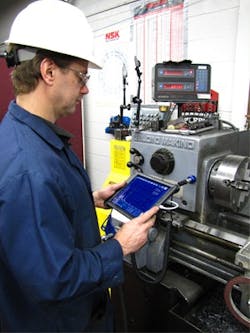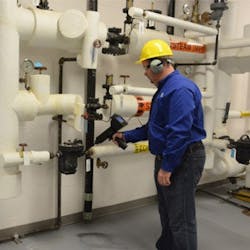Vibration analysis and ultrasound work together
It’s easy to regard vibration analysis and ultrasound as competing technologies. As these technologies grow and mature, however, the experts in both fields are coming to agree that, for many applications, vibration analysis and ultrasound are at their best when they are used together. Vibration analysis and ultrasound are often viewed as complementary parts of a complete condition monitoring toolkit. Sophisticated users select their technologies on a very individual basis. The choice takes into consideration equipment criticality, typical failure modes, the cost of failures, the cost of monitoring, the practicality of redundancy, and other characteristics of the business, the site, and the individual assets within it.
“We use both vibration analysis and ultrasound to monitor bearing condition and trends over time to predict bearing failure,” says Paul Berberian, vice president of predictive technology at GTI Predictive. “While we are using our vibration tools to determine root cause analysis for unbalance, misalignment, bearing defects, and looseness, ultrasound is a very good tool for determining when and how much to lubricate. This prevents overlubrication which is one of the main causes of bearing failure. Financially, if you correct the root cause and you lubricate it properly, a bearing should easily operate throughout its expected life.”
Traditionally, vibration and ultrasound inspections have been most popular in bearing monitoring, explains Alan Bandes, vice president of marketing at UE Systems. “Since ultrasound senses friction, it has gained popularity in lubrication programs where users can identify bearings in need of lubrication quickly, and, by incorporating equipment such as the grease caddy, lube techs can apply just the right amount of grease to prevent overlubrication,” he says. “Another use of the two technologies is basic bearing route inspection. Since ultrasound relies on just one test point, the time of inspection is cut by at least a third. Yet another application in which ultrasound has assisted vibration programs is inspection of slow-speed bearings. Ultrasound will detect the slightest signs of increased friction or early stages of spalling in a relatively short time.”
Figure 1. Combined use of vibration analysis and ultrasound also improves equipment availability and wrench time.
Combined use of vibration analysis and ultrasound also improves equipment availability and wrench time (Figure 1). “Ultrasound and vibration analysis have unique capabilities,” says Trent Phillips, condition monitoring manager at Ludeca. “However, they’re companion technologies, as well. Using both together can provide very early detection and confirmation of bearing faults, lubrication issues, and more. Additionally, the combination of these tools can deliver optimal use of manpower through more efficient condition monitoring coverage of important assets. All of this leads to increased time to plan and schedule activities that will keep equipment running upon demand. The result is reduced downtime, reduced costs, reduced risk, reduced spare parts usage, improved safety, increased capacity, increased uptime, and increased profits.”
The evolution of condition monitoring tools has proceeded against the backdrop of changes to statutory and technical issues in the businesses themselves. New motor technology, notably the spread of variable frequency drives (VFDs), has created new failure modes that must be monitored. New extraction techniques have pushed mining and drilling equipment in new directions, creating unprecedented environmental and mechanical challenges. Arc flash prevention has prompted changes to OSHA, NFPA, and NEC standards. With all these changes come new monitoring requirements.
Change calls for fresh thinking regarding the use of vibration analysis and ultrasound, as well as other condition monitoring tools. Use these tools, individually and in combination, to meet the evolving monitoring needs of equipment and the environments in which it operates.
Arc flash in the box
Ultrasound can be used to keep arc flash danger away from employees, explains T.J. Garten, electrical and energy subject matter expert at Allied Reliability Group. “During routine infrared electrical surveys, we have utilized acoustical ultrasound to assist with failing part identification, as well as severity determinations,” he says. “Listening for chattering contacts, intermittent auxiliary contact operation, starter coil assembly chatter, and coil winding electrical hum assists the analyst in providing corrective work orders. This information changes the work from a search-and-find mission to a planned repair that eliminates hot-spot chasing.”
Electrical inspection is a fairly new application for ultrasound technology, says Adrian Messer, operations manager at UE Systems, but its use hasn’t increased much in the past few years. “The main driver of this application is safety because we can typically inspect energized electrical equipment without having to open the panels and doors on the equipment,” explains Messer. “So, there’s little fear of creating an arc flash because we aren’t changing the environment inside of the equipment and we aren’t exposing ourselves to the energized electrical connections. Additionally, when ultrasound is used in conjunction with traditional infrared inspection, the user can scan with ultrasound prior to opening up the electrical equipment for the infrared inspection.”
Variable frequency drives
Applying both vibration and acoustical ultrasound for assessing the health of bearings hits the largest range of potential lifecycle anomalies, says Allied’s Garten. “Beyond just the routine bearing failure modes associated with lubrication and wear, effects of electrical transients and VFD-related anomalies have been identified with both technologies, leading to corrective action to the power circuit. This solved root causes rather than allowing repeat failures. There are slight differences in the data collected via vibration and ultrasound. This supports not just varying failure detection for trending and mitigation, but also the addition of varying alarm banding for anomalies beyond the normal mechanical focus. These anomalies are becoming more prevalent in the field.”
Allied has found value in applying acoustical ultrasound for assessment of several of the internal components for VFDs, as well, says Garten. “Utilizing acoustical ultrasound on these components has added value in assessing failures of these components prior to their normal end of lifecycle. Failures of iGBT assemblies, internal and external fans, and DC buss chargers all result in audible and spectral changes that trigger additional testing such as power quality assessment, motor current signature analysis, and field technical checks, to isolate and identify failures.”
A little vibration
Figure 2. Companies are requesting tablet apps for vibration monitoring.
Tom Hoenig, president of GTI Spindle Technology, describes an unusual shale processing application. “In most cases with vibration analysis we are looking to minimize vibration of machinery to prevent failures,” he says. “As the vibration increases at certain frequencies, we start planning for failures. In one case we were approached by a company who services shale shakers in the oil and gas industry. These are giant machines that sift large amounts of earth as their daily function. They only work well when they vibrate enough in the correct direction, frequency, and amplitude. So in other words less vibration means poor performance.”
The shale processor asked GTI to write an app that could run on GTI’s iPad vibration analyzer to inspect the peak performance of the vibration for its machines (Figure 2). The company needed to know how many Gs of vibration acceleration occurred at each mapped point on the machine, along with the frequency of that vibration. “They also needed to measure in two axes and show the vibration in an orbit plot,” explains Hoenig. “This way they could see the shake of the machine with two axis points of measure at each corner. The screen shots and reports generated by the iPad show the machine and all the points needed to be measured.”
Through the project, GTI learned not all equipment and assets are designed to minimize vibration, continues Hoenig. “Some equipment is made to vibrate to get the job done,” he explains. “Either way, vibration analysis again gives us the visual window to see the vibration and tell us if it is too much or not enough.”
Get the signal
Figure 3. The interest in using ultrasound for monitoring critical assets remotely and continuously is on the increase.
Getting to equipment to take readings can be a major challenge. “Critical equipment can be located on a train, ship, or a remote site that is difficult or dangerous to access by employees,” says Ludeca’s Phillips. “Unfortunately, in the past it was very difficult or impossible to apply vibration analysis on equipment under these circumstances. We have done a lot of work to make vibration analysis in these environments possible, and the process has been very exciting. The condition monitoring system continually monitors the health of the equipment under normal operating conditions. Operators, mechanics, and management can be actively alerted via email or text message when conditional changes occur on a monitored machine. The data is automatically transferred back to a centralized location for routine analysis so that corrective action can be taken before unwanted consequences occur. In addition, capabilities such as wireless vibration monitoring, cloud computing, remote monitoring capabilities, and services are now available. In the past two years we have released new multichannel real time vibration monitoring systems. Routine access to cranes and other types of equipment can be very difficult or impossible for routine condition monitoring. We have also installed wireless monitoring systems in these applications to overcome access and safety concerns and ensure that equipment health monitoring is provided.”
The interest in using ultrasound for monitoring critical assets remotely and continuously is on the increase, says UE’s Messer (Figure 3). “Junction boxes can now be used in conjunction with the handheld ultrasound instrument and remote-mounted ultrasound sensors to collect data on multiple points from one central location,” he says. “Other sensors are available that can be connected to PLCs and other online data monitoring systems to monitor both mechanical and electrical equipment. Examples of assets that can be monitored remotely with ultrasound include overhead cranes, enclosed electrical switchgear, robots, and remote pumping stations.”
Impact demodulation is a new wrinkle for vibration analysis installations. “By applying impact demodulation to vibration data, we are able to identify impact vibrations, which decay or ring down very rapidly, and lift them out of the steady background vibration for analysis,” says Steven Hudson, senior analyst at Azima DLI. “Picture separating cymbal crashes from a steady drum beat. The impact sounds typically begin to be emitted long before actual failures in elements like bearings. Adjustments to sample durations and sampling rates may be required to support precise analysis and avoid aliasing or shadow data, but the payoff is better long-term forecasting. This new capability is particularly useful for slower turning equipment that used to make impact data difficult to obtain.” A white paper on impact demodulation is available at www.plantservices.com/whitepapers/2014/impact-demodulation-identification/.
To introduce and grow vibration monitoring and ultrasound technologies in an organization, a starter application can help to break into an industrial setting. “Even though it has become common knowledge that ultrasound can be used for compressed air or gas leak detection, it never gets old to see someone who finds a compressed air or gas leak with ultrasound for the first time,” says Messer. “It’s even more satisfying when a facility begins to use ultrasound to find and then repair the leaks and the savings and benefits that are then associated with those efforts. Being able to quantify compressed air and gas leaks using ultrasound is always exciting and is typically a good start for someone who is implementing the technology into a reliability program. Being able to document savings associated with compressed air or gas leak detection with ultrasound typically leads to investments in additional training and other predictive technologies. Benefits also include reduced compressor demand, increased capacity on the overall compressed air system, and a reduction in the facility's carbon footprint by reducing the greenhouse gas emissions.”




